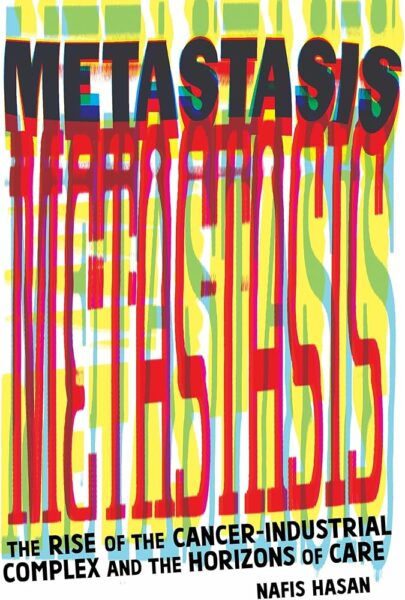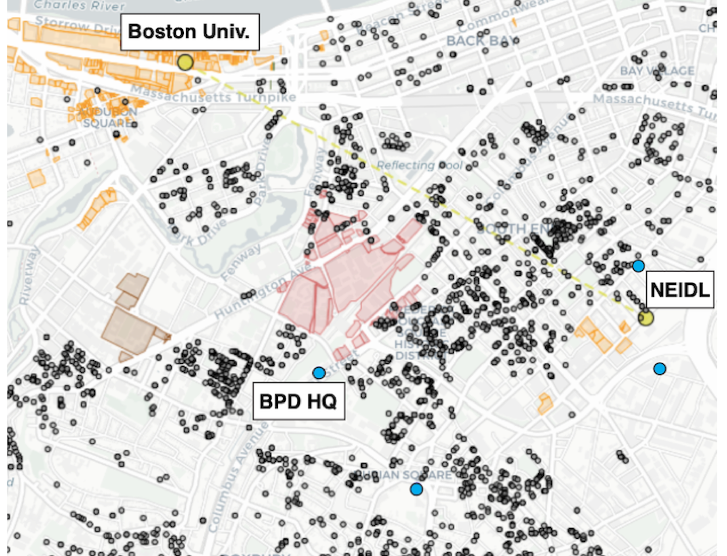August 25, 2025
Review
Dismantling the Cancer Industrial Complex
By Tayyaba Jiwani
“Cancer is a total social fact,” writes scientist, educator, and organiser Nafis Hasan (echoing anthropologist S. Lochlann Jain) in Metastasis: The Rise of the Cancer-Industrial Complex and the Horizons of Care.1 Indeed, cancer is becoming the defining health condition of our time. The global cancer burden continues to rise—it is now the second-leading cause of death in the United States.2 In the United Kingdom, one out of every two people are expected to have cancer at some point in their lives.3 This rise is often attributed to increasing lifespans, but in fact, cancer is rising in younger adults under fifty years of age.4

In Hasan’s telling, cancer is a disease of capitalism. It is not just that the disease symbolises the growth-addicted, violently expansionist, and self-destructive nature of capitalism. Instead, Metastasis lays out the story of cancer within an overarching narrative of neoliberal capitalism invading, infiltrating, and “subsuming” every sector of society—from academia to healthcare, government, and commerce—to shape the very carcinogenic ecosocial contexts we now inhabit. The book targets the “cancer-industrial complex:” the “symbiosis of private corporations, non-profit organizations, including universities and foundations, and public governmental regulatory bodies” that has formed on the terrain of cancer and serves to funnel public money and resources to private interests.5
The book is concerned with four major transformations led by capitalism that impinge on cancer: the geneticization of biology, the commercialisation of scientific research, the individualization of disease and medicine, and the deregulation of industry. In the first two chapters, Hasan revels in demolishing the reductionist gene-centric models that underpin cancer research and explains why they have yielded exorbitant but largely ineffective cancer drugs. These chapters also highlight the fundamentally flawed incentives at the heart of commercialised scientific research and drug development. The next two chapters trace the collaboration of the US government, pharma, and corporate interests to deregulate industry and healthcare, with a neoliberal reframing of disease as a problem of individual failure, not collective responsibility. Though focused on the US, which is arguably an extreme case of medical profiteering, this discussion nevertheless grants insight into larger global trends.
The book’s strength lies in exposing the links between seemingly distinct scientific, medical, and social spheres. But it is also original in its refusal to accept this state of affairs. Hasan underscores that defeating cancer requires nothing less than to challenge the power of capital. To that end, the last two chapters present sketches of both an alternative scientific framework for cancer research and medicine, as well as a blueprint for political struggles that can and must dismantle the cancer-industrial complex.
Hasan makes a powerful case for scientific workers to recognise their position among the working classes and mobilise to build collective power, to secure not just their livelihoods but the very integrity of their profession. He also traces a path for diverse struggles encompassing patient welfare, labor rights, ecological justice, and more, to find common ground to mobilize against the cancer-industrial complex. It is here that Metastasis showcases the breadth of Hasan’s expertise as a cancer biologist, dialectical scientist, critical theorist, and political organiser across multiple labor, ecosocialist, and radical struggles.
A minor thread of the book also explores the intertwined history of cancer and war through a loose collection of themes such as the carcinogenic impact of war, the role of defense contracts in research, and war metaphors in cancer medicine. However, the lens of imperialism would have offered a sharper analytical tool here, not only to clarify links between the military and economic dimensions of cancer, but also to bring into perspective contemporary forms of economic violence, such as US-driven intellectual property strangleholds restricting pharmaceutical access for cancer patients worldwide.
Not in Our Genes
Mainstream biology holds that cancer is a disease of cells and is caused by ‘bad’ genetic mutations. A bad mutation turns a healthy cell into a cancer cell, which is no longer able to control its multiplication. It now divides uncontrollably, producing more cancer cells that acquire further bad mutations, and so on. This Somatic Mutation Theory (SMT) underpins most cancer research and drug development today.
Hasan expertly takes apart SMT to expose the limitations of its reductionism against the complexity of biology, and thus its ineffectiveness in tackling cancer. For one, we have never found that one original cancer cell prescribed by SMT (what oncologist Azra Raza’s recent book calls the “first cell”), despite over a decade of funnelling money into ‘early detection’ research.6 Second, with recent technological advancements in gene sequencing, we have even more evidence that a group of normal healthy cells have many more mutations than a typical colony of cancer cells, including in cancer-related genes.7 This counters the notion that cancer cells are coherently genetically distinct from normal healthy cells. Furthermore, many known cancer-causing chemicals surprisingly cannot be found to cause DNA mutations, instead having other biological effects at the level of tissues and organs.8
These contradictions remain insufficiently addressed by an obsessive clinging to the genetic reductionism of SMT. Most current research aims (and fails) to find definitive gene mutations responsible for cancer, against which to design targeted drugs. However, as Hasan points out, the geneticization of cancer has not happened in a vacuum. Instead, “a confluence of neoliberalism, libertarian ideology and government policy has cemented the idea that genes are responsible for cancer.”9 He traces SMT’s rise to dominance to show that the technical models we use to understand nature are never apolitical or ideologically neutral.
Indeed, as late as the 1960s, the established view, endorsed by the World Health Organization, was that most human cancers result from environmental exposures and are preventable (the figure now stands at 40% of cancers).10 These included industrial and occupational exposures, which became apparent with the expansion of industrialization and the efforts of dedicated physicians, epidemiologists, and labor organisations.11 Studies from fossil fuel, mining, chemical, and agricultural industries have consistently highlighted the metals, solvents, fumes, and dusts driving cancers among workers, while spreading carcinogenic pollutants in the environment to affect us all.12
Nevertheless, instead of driving a concerted program to investigate, control, and eliminate these agents, Hasan describes how post-WWII federal research funding, public-private research partnerships, and corporate lobbying steered cancer science towards genetic explanations. Federal funding was channelled into finding one molecular cause after another, from viral agents to ‘rogue’ cells, chromosomes, oncogenes, and even smaller actors like single mutations or epigenetic “errors.” A far larger proportion of funding has been spent on studying molecular factors than environmental causes, even though prevention strategies addressing the latter have achieved more overall success in controlling cancer when implemented (e.g. asbestos control).
And yet, SMT has not been able to wish away the environmental dimension of cancer. After all, if cancer results from bad mutations, where do these come from? Only a small proportion of diagnosed cancers (10-15%) can be linked reliably to genetically inherited mutations.13 The rest are usually chalked up to mutations resulting from random chance or so-called “lifestyle exposures.” This terminology acknowledges the role of environmental factors, but shifts the blame on the individual by focusing on factors like smoking, obesity, and sun exposure. Notably, it elides systemically polluting carcinogens such as fossil fuels, plastics, pesticides, forever chemicals (e.g., PFAs), and industrial wastes.
Hasan shows how labor and environmental struggles in the 1960 and 1970s forced the US government to acknowledge these systemic carcinogens and institute landmark regulations for occupational safety and environmental protection. But a backlash in the form of industrial lobbying, creeping neoliberalisation, and the consolidation of the cancer-industrial complex from the 1980s steered research towards lifestyle factors. Smoking and diet were deliberately mobilized to counter environmental and occupational exposures as the main villains behind cancer, shifting the locus of cancer prevention from the socio-political sphere to the personal and behavioural.
Ironically, this shift is now coming full circle, through trendy new fields of epigenetics and exposomics, which Hasan does not discuss.14 Instrumentalising the language of cancer prevention, funding is now being poured into geneticizing lifestyle exposures. Exposomics studies how different exposures interact with our DNA, finding the “precise” genetic changes they cause so that these can be targeted with drugs. The field is generating significant hype under the new mantras of “precision prevention” or “personalised prevention.”
Needless to say, this line of research not only assumes reductively that environmental exposures cause genetic mutations, but serves to further atomise our environments. Its logical goal is not to demand the removal of toxins from our environments, but to “fix” our bodies to tolerate them.
In contrast to SMT, Hasan points to the existence of alternative biological theories for cancer, such as the Tissue Organization Field Theory (TOFT), and the larger theoretical framework of dialectical biology.15 These frameworks depart from a genetically reductionist understanding of living systems to one that accounts for multiple levels of biological complexity—genes, cells, tissues, organs, systems and environments. TOFT, for instance, posits that cancer is a disease not of cells but tissue systems, arising from disruptions in the internal organisation and communication that provide structure and stability to our tissues. While the theory has been at the margins of cancer research in the past few decades, Hasan and his scientific collaborators have contributed to the body of evidence in its support.
Given the elegance of TOFT as an explanatory framework and its marginalization from mainstream research, Metastasis would have benefited from a deeper discussion of the theory and its clinical implications. Similarly, Hasan’s discussion of theories of the organism in Chapter 5 remains at an abstract theoretical level, but more empirical elaboration would have been valuable.
The Mirage of Personalised Medicine
Conventional wisdom holds that Science is on a steady, linear march towards “progress.” Scientists make a hypothesis based on existing knowledge, test it using rationally designed experiments, and obtain evidence to draw a logical conclusion. Hasan’s discussion of cancer drugs turns this notion on its head. He shows how the genetic hypothesis of cancer—and its holy grail, precision oncology and personalized medicine—has failed over and over again. And yet, this hasn’t forced a serious reckoning, let alone a rejection, of the hypothesis.
The geneticization of cancer has led to a booming industry of gene-based treatments, resting on the logic that, since different people’s cancers result from different mutations, we must shift away from conventional ‘one-size-fits-all’ medicine towards tailored genetic drugs, i.e., personalized precision medicine. Every gene, molecule, or mutation is thus transformed into a potential target for drug development.
In his recent book Tyranny of the Gene: Personalised Medicine and Its Threat to Public Health, philosopher James Tabery has pointed to the illusion of personalized medicine, as “a marketing idea dreamed up by pharmaceutical executives.”16 He documents patients’ experiences of taking approved genetic diagnostic tests to identify the specific mutations underlying their disease, so that their treatment is personalised with the right drug, only for it to be ineffective or worse, harmful.
These effects are often chalked up to insufficient or incorrect data, making the case for more genetic studies in more patients, but there are other reasons that remain unacknowledged. These include the inherent redundancy of gene function (many genes can compensate for each other), the context-dependence of genes (the same gene can play different roles in different cells at different times), and more importantly, the insufficiency of solely genetic explanations of disease.
Moreover, they fail to account for cancer cells’ ability to evolve in response to environmental pressures. Thus, even if the ‘smoking gun’ gene is identified and the ‘magic bullet’ drug used against it, it remains possible for other mutations to arise, helping the cancer resist treatment and grow again. As both Tabery and Hasan note, the dream of personalized and precision medicine—“the right cure, for the right patient, at the right time”—has not materialized. But the search has come at the expense of public health and prevention research that could have been more effective.
The general failure of precision cancer therapies is not just rooted in the ideological blinkers imposed by gene-centric cancer theories like SMT. It also arises from the neoliberal disfiguring of the drug development pipeline for unbridled profit-seeking over patient interest. Pharma companies market genetic drugs at high rates for being research-intensive and risky to develop. However, Hasan methodically shows how drug companies creatively exaggerate their R&D costs, while offloading the riskiest phases of R&D to public-sector academic labs. It is these labs that develop and test potential new drugs, at the earliest stages when they are most likely to fail. The most promising compounds with the most commercial potential are then licensed to pharma companies.
More alarmingly, the clinical potential of new drugs is also exaggerated. Current regulations allow new drugs to be approved based on “surrogate endpoints,” such as tumour shrinkage or progression-free survival, rather than improvements in long-term survival or quality of life, which take longer to measure. Per one estimate, 74% of drugs approved between 2008-2012 failed to improve patients’ long-term survival.17 Moreover, US companies need not demonstrate that a new drug offers significant improvements over existing alternatives for it to be approved, leading to a glut of similarly (in)effective drugs in the market.
This discussion crystallises why, despite appearances, we haven’t seen meaningful improvements in cancer therapies. Hasan’s analysis is rigorously backed by peer-reviewed studies published by journals like Nature and The Lancet. It is a sobering indictment of the drug discovery and development pipeline, directed not for patient benefit but capital extraction for biotech companies and shareholders. Metastasis holds not just Big Pharma responsible, but also regulatory bodies, healthcare institutions and the larger cancer-industrial complex for profiteering collectively, at the expense of patients’ immiseration.
The Scientific Proletariat
Finally, Metastasis also draws attention to the neoliberal transformation of academia, leading to rising precarity in the scientific workforce, climbing productivity pressures, and perverse commercial incentives for research. In contrast to liberal handwringing, it correctly observes that this transformation underlies various crises facing the biomedical research ecosystem, such as the replication crisis, the retraction epidemic, and the explosion of predatory journals.
As a former cancer scientist myself, I find these insights painfully resonant. They reflect Hasan’s frustration after years at the lab bench straining against the intellectual blinkers imposed by reductionist, positivist, and neoliberal science. With the arrival of deep sequencing machines, black-box experimental kits, and AI-generated research, scientists are increasingly becoming technicians, colouring within the lines of pre-decided theoretical models.18 We are no longer even posing hypotheses (increasingly generated by AI-driven data analysis), much less questioning the epistemological or theoretical frameworks undergirding the algorithm.
While there have been calls for reform internally, little is done to challenge the fundamental issue: the systematic rewiring of Science for the purposes not of knowledge-seeking but quicker and greater profits. Metastasis critiques recent ‘popular’ mobilizations of US scientists like Stand Up for Science, pointing to the limits of lobbying elected representatives while insisting that science is apolitical. It exhorts scientific workers to recognize their position in the working class and build collective power.
Unfortunately, this prescription neglects the fact that scientists across the academic hierarchy have broadly supported (if not ignored) the neoliberal transformation of academia and its growing imbrication with the tech ecosystem. The latter has attracted scientists with the opportunity to turn new discoveries into start-ups and spin-offs with the potential to reap millions in venture capital investments. The incentives are perverse but powerful—the infamous Theranos or the recently exposed 23&Me are just two examples.19 It is this power, against the backdrop of capitalist realism, that we must challenge if we are to successfully organise scientific workers against the neoliberal transformation of the university. However, what may have seemed a tall order even as the book was being written may perhaps not seem so outlandish now, amidst a hostile government takeover powered by the most powerful and vile tech oligarchy in history.
Metastasis: The Rise of The Cancer-Industrial Complex and The Horizons of Care
Nafis Hasan
Common Notions Press
2025
272 pages
—
Tayyaba Jiwani completed her PhD in molecular biology from the University of Toronto and currently researches the political dimensions of genomics as a postdoctoral fellow at the University of Exeter. She is also an editor at Jamhoor, a South Asia-focused left media platform.
Notes
- S. Lochlann Jain, Malignant: How Cancer Becomes Us (Berkeley: University of California Press, 2013), 13-14.
- Sherry L. Murphy et al., “Mortality in the United States, 2023,” National Center for Health Statistics Data Brief, no. 521 (December 2024): Figure 4, https://dx.doi.org/10.15620/cdc/170564.
- Cancer Risk Statistics,” Cancer Research UK, accessed July 31, 2025, https://www.cancerresearchuk.org/health-professional/cancer-statistics/risk.
- Jianhui Zhao et al., “Global Trends in Incidence, Death, Burden and Risk Factors of Early Onset Cancer from 1990 to 2019,” BMJ Oncology 2, no. 1 (2023), https://doi.org/10.1136/bmjonc-2023-000049.
- Nafis Hasan, Metastatis: The Rise of the Cancer-Industrial Complex and the Horizons of Care,” (New York: Common Notions Press), xx. The term industrial complex, coined by President Dwight Eisenhower to describe the military-industrial complex, is widely used to refer to complex assemblages built to profiteer from public resources.
- Azra Raza, The First Cell: And the Human Costs of Pursuing Cancer to the Last (New York: Basic Books, 2020.
- Keren Yizhak et al., “RNA Sequence Analysis Reveals Macroscopic Somatic Clonal Expansion Across Normal Tissues,” Science364, no. 6444 (June 7, 2019), https://www.science.org/doi/10.1126/science.aaw0726.
- Siddharta Mukherjee, “All the Carcinogens We Cannot See,” New Yorker, December 11, 2023, https://www.newyorker.com/magazine/2023/12/18/all-the-carcinogens-we-cannot-see.
- Hasan, Metastasis, 40.
- Robert N. Proctor, Cancer Wars: How Politics Shapes What We Know and Don’t Know About Cancer (New York: Basic Books, 1996), 55.; Cancer Research UK, “Cancer Risk Statistics.”
- M. Weatherall, In Search of a Cure: A History of Pharmaceutical Discovery (Oxford: Oxford University Press, 1990), 211.
- Hasan, Metastasis, 26-27.
- “The Genetics of Cancer,” National Cancer Institute, accessed July 31, 2025, https://www.cancer.gov/about-cancer/causes-prevention/genetics; “Inherited Genes and Cancer Types,” Cancer Research UK, accessed July 31, 2025, https://www.cancerresearchuk.org/about-cancer/causes-of-cancer/inherited-cancer-genes-and-increased-cancer-risk/inherited-genes-and-cancer-types.
- “First NIH-Wide Exposome Research Coordinating Centre Launched,” National Institute of Environmental Health Sciences, accessed July 31, 2025, https://factor.niehs.nih.gov/2024/10/feature/1-feature-exposomics; Dimosthenis Sarigiannis et al., “Advancing Translational Exposomics: Bridging Genome, Exposome and Personalised Medicine,” Human Genomics 19, no. 48 (April 30, 2025), https://doi.org/10.1186/s40246-025-00761-6.
- Nafis Hasan, “Biology At Another Crossroads,” Science for the People (July 18, 2022), https://magazine.scienceforthepeople.org/lewontin-special-issue/biology-at-another-crossroads/; Richard Levins and Richard Lewontin, The Dialectical Biologist (Cambridge, Massachusetts: Harvard University Press, 1985).
- James Tabery, Tyranny of the Gene: Personalized Medicine and its Threat to Public Health (New York: Alfred A Knopf Inc, 2023).
- Chul Kim and Vinay Prasad, “Cancer Drugs Approved on the Basis of a Surrogate Endpoint and Subsequent Overall Survival: An Analysis of 5 Years of US Food and Drug Administration Approvals,” JAMA Internal Medicine 175, no. 2 (December 1, 2015), https://doi.org/10.1001/jamainternmed.2015.5868.
- Ana M Soto and Carlos Sonnenschein, “The Proletarianization of Biological Thought,” Philosophy World Democracy, November 15, 2021, https://www.philosophy-world-democracy.org/articles-1/the-proletarianization-of-biological-thought.
- Editorial, “Burst Bubbles,” Nature 526 (October 28, 2025): 609-610, https://doi.org/10.1038/526609b.





